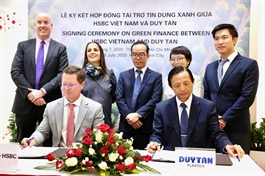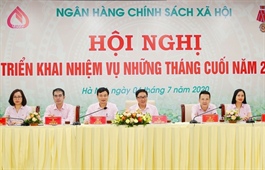All change at the top as insurers look to the future
All change at the top as insurers look to the future
Local and foreign insurers are expanding their foothold in the lucrative insurance market and bringing about a range of changes, from new high-profile names joining the competition to management reshuffles.

All change at the top as insurers look to the future - illustration photo/ Shutterstock
|
Canada’s Manulife Financial Corporation is now emerging as the leading bidder for British insurer Aviva Plc.’s subsidiary in Vietnam as part of its focus on Southeast Asia. Last December, Bloomberg reported that Japan’s MS&AD Insurance Group Holdings and Manulife were mulling over acquiring Aviva assets in Singapore and Vietnam. Negotiating is underway, with the bancassurance deal roughly calculated to be worth several hundred million US dollars.
Earlier last month, German insurer Allianz was reportedly pursuing a strategic agreement to jump on the property and casualty bandwagon, with the target date also set for 2021. The company is negotiating with local regulators, hence a potential takeover deal or a new digital platform is on the cards.
“Vietnam is one of the fastest-growing economies in Asia, with a general insurance market which is expected to experience robust growth. Combined with Vietnam’s high internet and mobile penetration, the country is well placed for increased access to digital insurance solutions,” the firm said in its statement.
Allianz once showed its interest in buying Aviva Vietnam, and also formed a joint venture with Vietnam’s software and IT developer FPT.
“In markets where we have no existing legacy such as Vietnam, we continue to explore entry with a new digital or digital-hybrid business model,” Allianz confirmed with InsuranceAsianNews.
Meanwhile, international investors could reap the benefits from state divestment in some major insurers.
Last week, Post and Telecommunication Joint Stock Insurance Corporation lifted its foreign ownership cap to 100 from 49 per cent. The move signals its ambition of raising charter capital, which is also a necessary condition to boost its international credit ratings and expand its operation.
State-owned petrol distributor Petrolimex also plans to reduce its stake in PG Insurance PJICO from 40.95 to 35.1 per cent.
Meanwhile, foreign insurers AXA from France and Firstland from Hong Kong (China) are expressing their appetite about buying more stakes in Bao Minh Insurance, which is signalling its ease of previous foreign ownership limit.
The newly ratified EU-Vietnam Free Trade Agreement (EVFTA) is also slated to embody the extraordinary step ahead of Vietnam’s potentials for overseas funds, especially European insurers. Under the EVFTA, Vietnam allows foreigners to form joint venture insurance businesses; 100 per cent EU-owned insurers offering insurance services including: (1) original insurance (life insurance, except health insurance, non-life insurance), (2) reinsurance and retrocession reinsurance, (3) insurance intermediaries (agents and brokers), (4) insurance support services (consulting, risk assessment, compensation settlement).
Recently, HD Insurance was officially established and licensed, becoming the 67th insurer in Vietnam with charter capital of VND1.8 trillion ($78.26 million). Regardless of insurance brokers, HD Insurance is the first company to be established since OPES Insurance – an associate of VPBank – in 2018.
Nguyen Thi Phuong Thao, president and CEO of Vietjet cum deputy chairwoman of HD Bank, is the chairwoman of the member’s council at HD Insurance. Thao is known for being the first self-made female billionaire in Southeast Asia.
The introduction of HD Insurance is slated to further strengthen its ecosystem in Vietnam, with a wide range of lucrative businesses such as HD Bank, HD Saison, Vietjet, and Sovico Holdings, among others. The firm also recruited Pham Khac Dung – former chairman of PVI Reinsurance – as CEO. Furthermore, former deputy CEO of PVI Nguyen Quang Vinh is allegedly playing an essential role in the HD Insurance team.
Last month, British insurer Prudential Vietnam appointed Phuong Tien Minh as new CEO. In his new role, Minh will be responsible for driving Prudential Vietnam’s strategy to expand its footprint across the country and provide Vietnamese with greater access to its suite of insurance and investment solutions.
Meanwhile, leading pan-Asian insurer FWD Group confirmed securing regulatory approval to proceed with the previously announced acquisition of Vietcombank-Cardif Life Insurance, a joint venture between state-owned Vietcombank and French partner BNP Paribas Cardif. The tie-up, rumoured to be worth anywhere between $400 million and $1 billion, is envisaged to cement FWD’s ambition in the country.
FWD CEO Huynh Thanh Phong was also the first CEO of Prudential Vietnam. Phong took over the company at an early stage and helped give it a definite structure.
In March, Duong Thanh Danh Francois, formerly of PVI Holdings, was appointed as chairman of the members’ council of PVI Insurance. Francois is also director of Asia-Pacific (except Japan) of HDI Global SE.
Last week, PVI was approved by the Ministry of Finance to increase its charter capital to VND3.1 trillion ($134.8 million). Accordingly, the firm now becomes the largest non-life insurer in Vietnam.
Nguyen Khac Thanh Dat – former deputy country president cum chief agency officer of Chubb Life Vietnam – is reportedly switching to another insurer.
According to one industry insider, frequent reshuffling of key personnel is one of the characteristic features of the insurance sector. “Insurance companies here have undergone significant management reshuffle for a long time since expectations from boards have put enormous pressure on these key personnel,” the expert said.
On the other hand, low domestic interest rates and economic downturn are anticipated to adversely impact insurers, particularly life insurers, due to their fixed-income securities. But in the long term, the local insurance sector remains attractive for investors, especially foreigners in the context of low penetration rates and an emerging middle class.
























